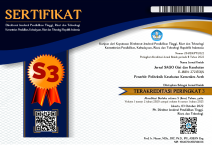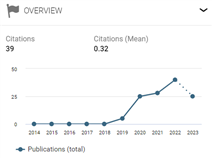The relationship between pain intensity and sleep quality in various type of elective postoperative patients at Prof. Dr. Chairuddin P. Lubis USU Medan Hospital
DOI: 10.30867/gikes.v6i2.2659Abstract
Background: Postoperative pain arises after surgery and includes acute pain that needs to be treated immediately.
The postoperative phase must always be observed because it relates to the patient's recovery process. The prevalence of postoperative pain varies widely around the world, with the United States at 86%, Europe at 70%, and China at 48.7%. The prevalence of postoperative pain in Indonesia has not been studied as a whole.
Objectives: The research aims to analysed the relationship between pain intensity and sleep quality in elective postoperative patients at Prof. dr. Chairuddin P. Lubis USU Medan Hospital.
Methods: The research used an analytical observation using a cross-sectional approach with a consecutive sampling design. Respondents' data was collected only once and simultaneously using the Numeric Pain Rating Scale (NRS) and Pittsburgh Sleep Quality Index (PSQI) questionnaires. The data will be analysed using the Statistical Package for the Social Sciences (SPSS), including Somers'd test.
Results: Based on the analysis of 125 respondents' data, the highest experienced pain intensity by patients was moderate pain intensity with 49,6%, mild pain intensity with 38,4%, and severe pain intensity 12%. In the sleep quality, the poor sleep quality group was the highest, with 54,4% and the good sleep quality group 45,6%. Respondents in this research were majority aged 26–35 years with 37 respondents. This analysis shows a significant relationship and very strong correlation between pain intensity and sleep quality (p-value <0,001 and r = 0,789).
Conclusion: There is a relationship between pain intensity and sleep quality in elective postoperative patients at Prof. dr. Chairuddin P. Lubis USU Medan Hospital.
Keywords
Full Text:
PDFReferences
Chou, R., Gordon, D. B., de Leon-Casasola, O. A., Rosenberg, J. M., Bickler, S., Brennan, T., Carter, T., Cassidy, C. L., Chittenden, E. H., Degenhardt, E., Griffith, S., Manworren, R., McCarberg, B., Montgomery, R., Murphy, J., Perkal, M. F., Suresh, S., Sluka, K., Strassels, S., … Wu, C. L. (2016). Management of postoperative pain: a clinical practice guideline from the american pain society, the american society of regional anesthesia and pain medicine, and the american society of anesthesiologists’ committee on regional anesthesia, executive committee, and administrative council. The Journal of Pain, 17(2), 131–157. https://doi.org/10.1016/j.jpain.2015.12.008
Denisah. (2023). Hubungan intensitas nyeri dengan kualitas tidur pada pasien pasca pembedahan di RS PKU Muhammadiyah Yogyakarta [Universitas ’Aisyiyah Yogyakarta]. https://digilib.unisayogya.ac.id/6963/
Fitri, L., Amalia, R., & Juanita. (2022). Hubungan jenis kelamin dengan kualitas tidur lansia. jurnal ilmiah mahasiswa. Fakultas Keperawatan, 4, 65–69. https://jim.usk.ac.id/FKep/article/view/19994/9736
Hamdiah, D.-, & Budiyanto, A. (2022). Hubungan antara nyeri dan kecemasan dengan kualitas tidur pada pasien pasca operasi di ruang bedah. Ghidza: Jurnal Gizi Dan Kesehatan, 6(2), 191–199. https://doi.org/10.22487/ghidza.v6i2.564
Hidayatulloh, A. I., Limbong, E. O., Ibrahim, K., & Nandang. (2020). Pengalaman dan manajemen nyeri pasien pasca operasi di Ruang Kemuning V RSUP Dr. Hasan Sadikin Bandung: (Studi Kasus). Jurnal Ilmu Keperawatan Dan Kebidanan, 11(2), 187–204. https://doi.org/https://doi.org/10.26751/jikk.v11i2.795
Husada, M. A. (2022). Gambaran tingkat nyeri pada pasien post operasi di Ruang Rawat Inap RSUD Sungai Lilin Tahun 2022 [Program Studi D4 Keperawatan Anestesiologi]. Institut Teknologi dan Kesehatan Bali.
Kazharo, A. (2020). Hubungan tingkat nyeri dengan kualitas tidur pada pasien post operasi di Rumah Sakit Tingkat III Baladhika Husada Jember [Universitas Jember]. http://repository.unej.ac.id/handle/123456789/103712
Liu, Y., Xiao, S., Yang, H., Lv, X., Hou, A., Ma, Y., Jiang, Y., Duan, C., Mi, W., Yang, J., Liu, D., Li, M., Zhang, J., Yang, Y., Diao, Y., Han, R., Song, S., Li, N., Yue, X., … Zhang, T. (2023). Postoperative pain-related outcomes and perioperative pain management in China: a population-based study. The Lancet Regional Health - Western Pacific, 39, 100822. https://doi.org/10.1016/j.lanwpc.2023.100822
Ngestu, C. I. N. P., Utomo, D. E., & Sartika, I. (2024). Hubungan antara tingkat nyeri dengan kualitas tidur pada pasien pasca
bedah ruangan bima. Gudang Jurnal Ilmu Kesehatan, 2(2), 223–227. https://doi.org/10.59435/gjik.v2i2.835
Ninashvili, N., Mchedlishvili, I., Giorgobiani, L., Tchaava, K., Shavdia, N., Gegeshidze, N., & Meburishvili, N. (2023). Acute post-operative pain intensity and associated factor in patients at different surgical departments of a referral hospital. Experimental & Clinical Medicine Georgia. https://doi.org/10.52340/jecm.2023.04.46
Purnawanti, Y. (2023). Hubungan antara tingkat nyeri dengan kualitas tidur pada pasien pasca operasi di Rumah Sakit Islam Banjarnegara. Universitas Islam Sultan Agung.
Sjamsuhidajat, & De Jong. (2017). Buku Ajar Ilmu Bedah Edisi 4 (Vol. 1), 332-333.
Su, X., & Wang, D.-X. (2018). Improve postoperative sleep: What can we do? Current Opinion in Anesthesiology, 31(1), 83–88. https://doi.org/10.1097/ACO.0000000000000538
Tegene, S. S., & Alemnew, E. F. (2022). Postoperative poor sleep quality and its associated factors among adult patients: A multicenter cross-sectional study. Annals of Medicine and Surgery, 74. https://doi.org/10.1016/j.amsu.2022.103273
Wiguna, K. A. A., Aribawa, I. G. N. M., Aryabiantara, I. W., & Senapathi, T. G. A. (2021). Gambaran intensitas nyeri pasien pascaoperasi abdomen bawah di RSUP Sanglah. E-Jurnal Medika Udayana, 10(8), 104. https://doi.org/10.24843/MU.2021.V10.i8.P17
Wijaya, I. P. A. (2018). Analisis faktor-faktor yang mempengaruhi intensitas nyeri pasien pasca bedah abdomen dalam konteks asuhan keperawatan di RSUD Badung Bali.
Jurnal Dunia Kesehatan, 5(1)
Refbacks
- There are currently no refbacks.














